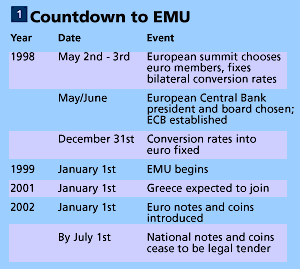
SURVEY EMU
An Awfully Big Adventure
The history of an
idea
EU
Search
archive
The European economies are ill-prepared for the euro, which will arrive in less than nine months’ time. To ensure its success, they will need to become far more flexible and competitive, says John Peet
 |
|
FOR Peter Pan, the Awfully Big Adventure was death. The advent of Europe’s single currency, the euro, may merely be “purgatory”, according to Antonio Fazio, governor of the Bank of Italy. But there is no doubt that European economic and monetary union (EMU), due to start next January, is a big and potentially risky step, both politically and economically. The euro will be the most visible proof yet that Europe’s citizens are part of a wider European Union. As adventures go, this one will be historic.
Eurosceptics like to claim that the single currency was foisted on Europe by Germany’s Helmut Kohl and France’s François Mitterrand, egged on by the European Commission president, Jacques Delors, at the Maastricht summit in December 1991. Yet the idea can be traced back at least to the start of the common market in 1958 (see article). Its roots go back further still. Over 130 years ago France set up a Latin Monetary Union that also embraced the unlikely quintet of Belgium, Italy, Switzerland, Bulgaria and Greece. At the time Walter Bagehot, the editor of this newspaper, commented with what now looks like remarkable prescience:
|
If we do nothing, what then? Why, we shall be left out in the cold . . . Before long, all Europe, save England, will have one money, and England be left standing with another money. |
|
From summit to molehill
Formally speaking, these questions will be decided on May 2nd-3rd, when Europe’s heads of government meet in Brussels to select the first round of participants in the euro. The summit leaders will cast a qualified majority vote (in which each country’s vote is weighted according to its size) on the list of candidates proposed by the European Commission in its recent “convergence report”. To help them make up their minds, the leaders will also have a report from the European Monetary Institute, the forerunner of the European Central Bank; opinions from the European Parliament; and reports from some national central banks, including the German Bundesbank and the Bank of France.
With such a mountain of paper to be tackled, the summit promised at one time to degenerate into one of those classic nail-biting EU negotiations in which votes are traded off, bargains are struck on wholly unrelated issues and sessions drift tensely through the night—with the added piquancy that the meeting will be chaired by someone with no direct stake in the subject. Although Britain has opted against taking part in the euro for now, its prime minister, Tony Blair, will be presiding over the meeting because Britain currently holds the six-monthly EU presidency.
However, the May summit is already beginning to look like an anti-climax. Following the commission’s report, it seems all but certain that 11 of the EU’s 15 members will join the euro. Greece is keen, but will have to wait because it cannot for now pass the Maastricht tests. Only Britain, Denmark and Sweden will stand aside by choice. The press has been squared, the markets prepared; even speculators are quiescent. A last-minute court challenge in Germany was dismissed on April 2nd.
As if to defy the speculators, bilateral conversion rates between currencies will also be fixed at the May summit. Conversion rates into the euro cannot be set until December 31st, because one euro has to equal one ecu, which includes three currencies (those of Britain, Denmark and Greece) that will not be in the euro. After that date there will be a three-year transition period during which national currencies will continue to exist, but as subdivisions of the euro. On January 1st 2002, euro banknotes and coins will be introduced; soon after that national banknotes and coins will cease to be legal tender (see table 1).
 |
|
Why has the arrival of the euro become such a certainty, after the earlier doubts? Largely thanks to the economy. When the Maastricht treaty was signed, there seemed plenty of time for EU member governments to rein in inflation and put fiscal houses in order before the single currency was launched. It also seemed likely that only seven or eight countries would join initially. But a wrenching recession in the early 1990s, combined with the near-collapse of the European exchange-rate mechanism in 1992-93, put the first at risk. At the same time governments such as Italy’s and Spain’s started to protest noisily about the possibility of being left out. The result was much speculation about delay or even cancellation of EMU.
Most European leaders, notably Helmut Kohl, stood firm, as did the European Commission. The figures for the Maastricht criteria were judiciously fudged, even in Germany. Yet as recently as last summer, promises that the single currency would arrive on time still looked other-worldly. Then, at last, Europe’s economies sputtered into life. Now the recovery seems increasingly robust, despite the aftershocks of the Asian crisis. It is this, more than any quantity of fudge, that has made the task of qualifying under the Maastricht criteria easier than expected. The Union’s average growth rate this year and next is now expected to be 2.8% and 3% respectively, the fastest of the decade, though fallout from the Asian crisis may yet reduce these numbers. Unemployment in all EU countries, even Germany, is at last heading down—although it is still much too high. Inflation everywhere remains subdued.
In short, and to a large extent by chance, the euro should begin its life against the best economic background in ten years. That is fortunate for companies, banks and financial institutions, for the transition to the euro is going to be costly for them. Yet even this has its advantages. Yves-Thibault de Silguy, the European commissioner for monetary affairs, points out that spending on preparations for the euro, coming on top of spending to avert the millennium computer time-bomb, will itself give Europe’s economies a boost.
Now make it work
So far, then, the eurosceptics have been proved wrong. But now attention is switching to the far trickier questions of how 11 disparate European economies (and perhaps more, as latecomers join) will cope with a single monetary policy and the loss of all their exchange-rate flexibility; how the untried European Central Bank will perform; and what will happen when the EU economies next hit a downturn. These questions form the main subject for this survey.
The place to begin is with the economics of a single currency. It is, after all, in the first instance an economic idea, even if it has now become mainly a political matter. Sadly, if predictably, economists are unable to agree on its effects—still less on its desirability.